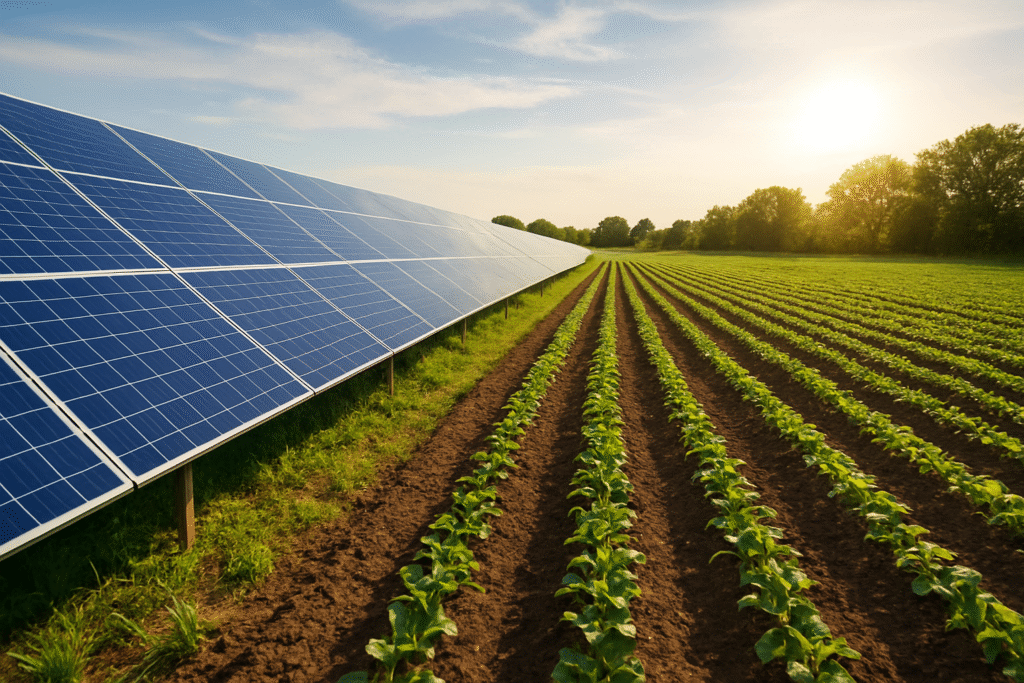How the Sun Is Transforming Modern Agriculture

Farming is changing fast — and solar energy is leading the way. Across the world, more farmers are switching to solar for agriculture to power their fields, reduce costs, and protect the planet. This guide breaks down how solar technology is transforming everyday farm life, from irrigation and storage to crop growth and financial sustainability.
The Rise of Solar Farming
Why Farmers Are Embracing Solar Energy
Traditional farming methods often rely on expensive and unreliable energy sources. That’s why more farms are turning to solar energy solutions to run their operations sustainably. Solar panels now power water pumps, machinery, and even livestock shelters — helping farmers save money while cutting carbon emissions.
How Solar Helps Crops Grow Better
Beyond just powering equipment, solar-powered lighting systems and climate control tools are reshaping how crops grow. By optimizing sunlight exposure and regulating greenhouse temperatures, farmers can boost photosynthesis and achieve higher, healthier yields — even during off-seasons.
Smart Tech: Making Farms More Efficient
Solar-Powered Irrigation Systems
One of the biggest game changers is the solar irrigation system. Instead of relying on diesel or the grid, solar pumps draw power straight from the sun — saving on fuel costs and ensuring reliable water supply. These systems also help conserve water by integrating with smart sensors, creating a balance between sustainability and efficiency.
Learn more about how solar water systems help farms save both energy and resources in this guide on exploring solar energy storage.
Precision Farming with Solar Drones
Tech-savvy farmers are using solar drones to monitor crops, detect pests, and predict yields. These solar-powered drones stay airborne longer thanks to sunlight, giving farmers accurate insights through aerial imaging. That means fewer wasted resources and better crop management overall.
The Financial Side of Going Solar
Saving Money and Gaining Independence
Switching to solar is an investment that quickly pays off. Farmers who adopt solar technology enjoy lower utility bills, tax incentives, and reduced dependency on fossil fuels. Some regions even offer special programs that reward farms for producing excess clean energy.
Solar Leasing and Financing Options
Not every farmer can afford the upfront cost of solar panels — and that’s okay. Many companies now offer solar leasing or power purchase agreements (PPAs) designed specifically for agriculture. These programs let farmers use solar power without heavy initial costs, making clean energy more accessible to everyone.
You can learn more about the pros and cons of local and national solar installers before choosing the right provider for your farm.
Real-World Uses: Solar on the Farm
Solar-Powered Cold Storage
Food waste is a huge issue, especially post-harvest. Solar-powered cold storage facilities are helping farmers keep produce fresh longer — even in remote areas. With renewable energy powering their chillers, farmers reduce spoilage and maintain product quality. Explore more on how solar energy storage is changing the way farms manage perishable goods.
Solar Greenhouses: Growing More with Less
Pairing solar technology with greenhouse farming is another innovation on the rise. Solar panels can run heating, cooling, and watering systems inside greenhouses, extending the growing season and cutting down costs. It’s a smart way to make year-round farming possible while staying eco-friendly.
FAQs About Solar for Agriculture
Q: How does solar energy support sustainable farming?
A: Solar power minimizes environmental impact by replacing fossil fuels with renewable energy, helping farms cut emissions and protect soil health.
Q: Can solar installations work on small farms?
A: Absolutely. Solar systems are scalable and can be customized to fit everything from small plots to large agricultural operations.
Q: What financial support is available?
A: Many governments offer grants, subsidies, and tax credits to encourage solar adoption in agriculture.
Q: Will solar irrigation work on cloudy days?
A: Yes — most systems now come with battery storage to ensure continuous operation even when sunlight is limited.
Q: How do solar drones help with pest control?
A: Drones use infrared and multispectral imaging to spot pest issues early, enabling farmers to take eco-friendly action before infestations spread.
Final Thoughts
Solar energy is more than just an upgrade — it’s a revolution for modern farming. From irrigation and cold storage to precision drones and greenhouse systems, solar power is giving farmers the tools to work smarter, save money, and protect the environment.
By embracing solar for agriculture, farmers can cultivate a future that’s cleaner, greener, and more resilient — powered by nothing but the sun.